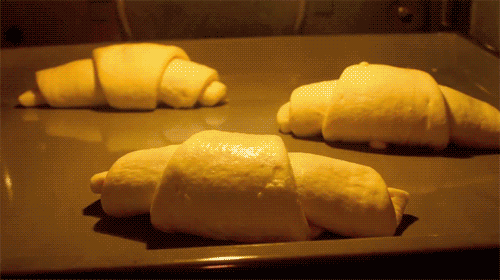Briana's Mini Crisp Croissants💜
I chose to make croissants. I know, I asked myself why too. It takes a lot of patience to make croissants and it requires very specific amounts of ingredients, but I chose to look closely at how different amounts of yeast affects this process. Will it crumble, rise, taste chewy, or nice and buttery?
The Science of Yeast:
Yeast is an agent in baking that turns the sugars in the bread product (dough) into carbon dioxide and ethanol/energy.It helps the process of fermentation, the process in which the dough begins to rise. The yeast has to be mixed with water and sugar to become activated. It needs to remain at a certain temperature. Being too hot or too cold can kill the yeast, jut like specific amounts of yeast can cause the dough to rise or stay the same.

Experiment and Results:
The independent variable in my cool experiment was the amount of yeast used. All the other ingredients used were all kept the same in the other trials.
Recipe and precise instructions (pay VERY close attention!!!)
- Preheat the oven to 400 degrees
- In a bowl, pour 1.6 cups of warm milk, 1 cup of melted butter, and desired amount of yeast (see results)
- DO NOT stir mixture. Cover it, and let it sit for 10 mins
- After 10 minutes is up, add 4 cups of flour and knead thoroughly; let dough sit for 30 mins
- Flour your work area and spread out dough; layer about 3 pieces and make sure all pieces are covered with butter
- Cover layered pieces and place in the freezer for 1 hour
- Once removed from freezer, cut the dough in pieces to begin forming the shape of a croissant
- Place on buttered cookie sheet and let cook for 20-25 minutes until golden brown on both sides and fluffy
Trial One: 1 ¼ teaspoons
I won't even lie, this trial was horrible, and not edible, it barely rose while in the oven and, it did not brown well on either side. The taste was not consistent, meaning it did not taste like it was cooked all the way through. It was flatter and began to fall apart.
Trial Two: 5 teaspoons
This cooked a little better, but had close to the same results. The only characteristic that differed was the color. This batch of croissants had a darker color, but not the exact color a croissant should have. It also began to rise after like 4 mins, but quickly fell. It was still soft and too chewy. Not edible at all, well not for me anyway.
Trial Three: 2 ¼ teaspoons
This was definitely my type of croissant.Rich in color and taste, and browned to perfection, how could life have gotten any better? Rose perfectly and immediately. Just overall, probably the best croissant I've ever made :)
Putting all of this together, the amount of yeast you use will most definitely affect the baking of a croissant. So, using too much or too little will have you end up with a croissant you will not eat (guaranteed fact). Yeast does not only help the dough rise after the air bubbles are released, but it also helps the croissant cook and taste better. The more yeast used, the faster and more efficient the dough will rise. With the dough rising it helps the dough evenly cook all throughout it. Think about it with the example of gas in car. In order for the car to run , it has to have the right amount of gas in it. Just like in order for the fermentation process to happen, there has to be enough yeast.
Comments
Post a Comment